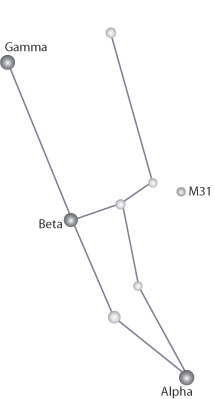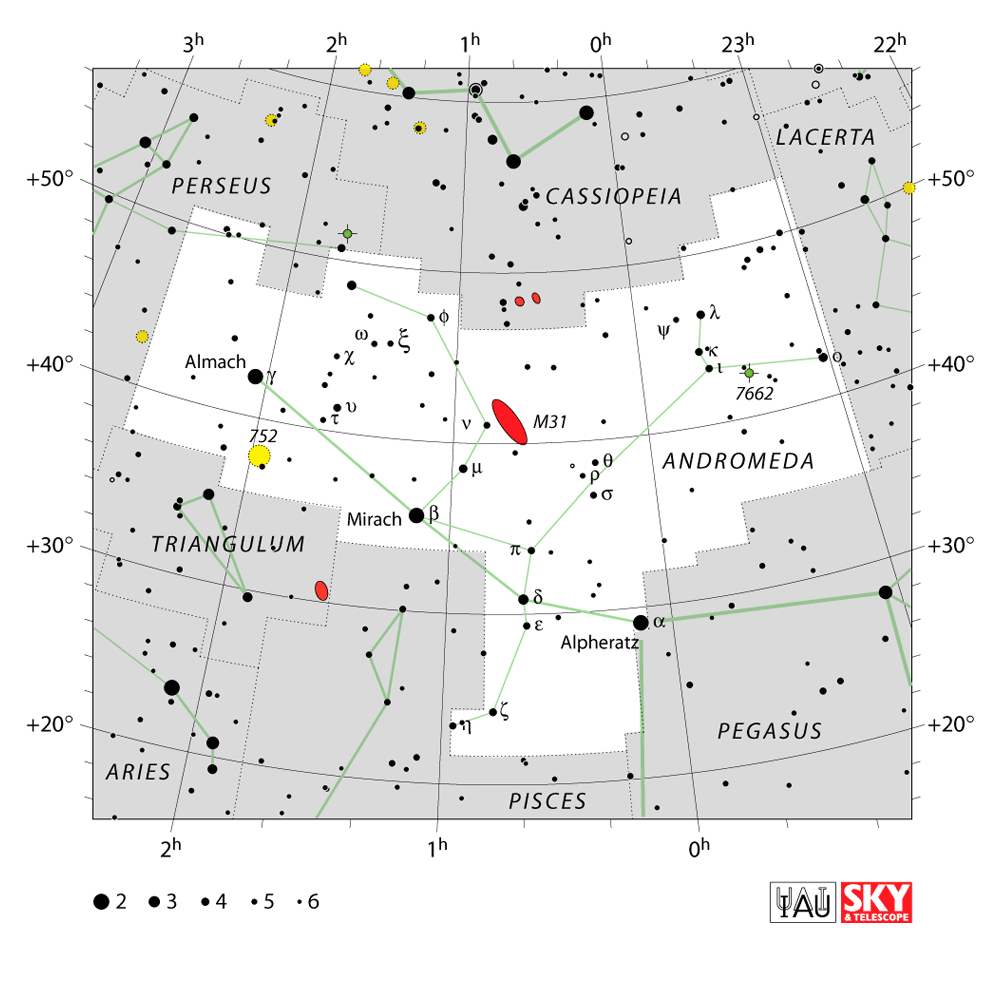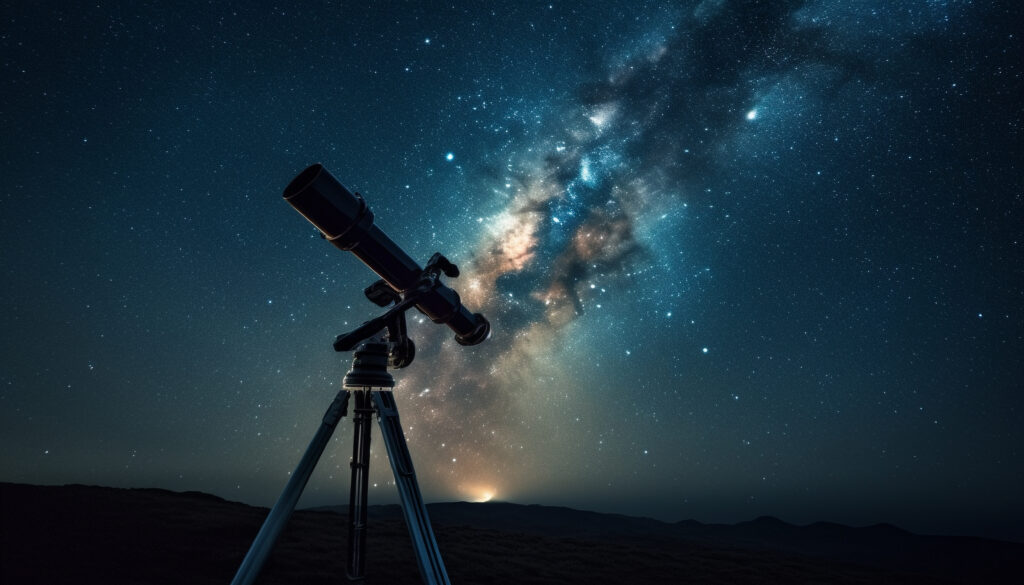Journeying through the Andromeda Constellation
© NASA
Table of Contents
The Andromeda constellation, featuring 16 visible stars in the northern sky, draws its name from the mythological Andromeda princess, as designated by ancient Greeks. This celestial expanse encompasses the Andromeda Galaxy, the closest full-fledged galaxy to our Milky Way. Listed among the 48 constellations by the 2nd-century astronomer Ptolemy, Andromeda is now recognized as one of the 88 modern constellations.
Best observed during autumn evenings in the Northern Hemisphere, Andromeda constellation shares the celestial stage with other constellations linked to characters in the Perseus myth. Due to its northern declination, the constellation becomes invisible south of 40° south latitude, lying below the horizon for observers in more southern regions. Encompassing a vast area of 722 square degrees, Andromeda ranks as one of the largest constellations, surpassing the size of the full moon by over 1,400 times. It occupies 55% of the largest constellation, Hydra, and is more than 10 times the size of the smallest constellation, Crux.
Alpha Andromedae, the constellation’s brightest star, is a binary star system that has also been associated with Pegasus. In contrast, Gamma Andromedae is a captivating binary star, known for its vibrant hues, making it a favored target for amateur astronomers. Just slightly less luminous than Alpha, Beta Andromedae takes on a striking red giant appearance, its color discernible to the naked eye.
Andromeda’s most prominent deep-sky object is the Andromeda Galaxy (M31), colloquially known as the Great Galaxy of Andromeda. It is the nearest spiral galaxy to the Milky Way and stands as one of the brightest objects in the Messier catalog. Within the boundaries of Andromeda, a collection of fainter galaxies, including M31’s companions M110 and M32, as well as the more distant NGC 891, adds to the celestial spectacle. Additionally, observers can catch sight of the Blue Snowball Nebula, a planetary nebula presenting itself as a distinct blue circular object when viewed through a telescope.
STAR DETAILS

In the expansive canvas of the Andromeda Constellation, a stellar ensemble graces the night sky, each star telling its own tale of brilliance and significance. Let’s explore the notable stars that contribute to the celestial symphony of Andromeda:
ALPHERATZ (ALPHA ANDROMEDA)
Nestled at the northeastern corner of the “Great Square of Pegasus,” Alpheratz stands as the luminous jewel in the celestial crown of the Andromeda Constellation. This binary star system is the brightest in its constellation and possesses a dual identity, as it also marks the head of the mythical winged horse, Pegasus. Alpheratz shines with a captivating brilliance, casting its radiant light across the cosmic expanse. Its shared prominence between Andromeda and Pegasus adds a touch of celestial intrigue, inviting stargazers to gaze upon this stellar gem that has graced the night sky with its luminosity and mythical connections throughout the ages.
MIRACH (BETA ANDROMEDA)
Mirach, a celestial gem in the Andromeda Constellation, captivates observers with its distinct reddish glow. As a red giant star, Mirach stands out as one of the most luminous stars in this cosmic tapestry. Its warm hue adds a touch of majesty to the night sky, creating a visual spectacle that beckons stargazers. Mirach’s presence contributes to the celestial symphony of Andromeda, reminding us of the diverse and captivating nature of the stars that adorn our cosmic neighbourhood.
MU ANDROMEDAE (MU ADD)
Mu Andromedae, a captivating binary star system, performs a celestial ballet in the heart of the Andromeda Constellation. Comprising two yellow-white dwarf stars, Mu Andromedae engages observers with its dynamic dance. The interaction between these stellar companions adds a sense of cosmic choreography to the night sky, inviting astronomers to witness the intricacies of their gravitational interplay. As a stellar pair, Mu Andromedae contributes to the rich astronomical narrative of Andromeda, showcasing the interconnected beauty of the stars that adorn our vast celestial canvas.
DELTA ANDROMEDAE (DELTA ADD)
Delta Andromedae, a captivating multiple-star system, graces the celestial stage in the Andromeda Constellation. Comprising four stars, with Delta Andromedae A as the primary component, this stellar quartet unveils a visual spectacle for stargazers. The system’s binary nature and the complex gravitational interactions among its stars add dynamism to the cosmic panorama. Delta Andromedae invites astronomers to witness the intricacies of its celestial ballet, a testament to the captivating diversity within the stellar tapestry of Andromeda. As observers peer into the night sky, Delta Andromedae stands as a stellar beacon, showcasing the harmonious dance of multiple stars in our cosmic neighbourhood.
SCHEDAR (ALPHA CASSIOPEIAE)
Schedar, officially designated Alpha Cassiopeiae but sharing its brilliance with the Andromeda Constellation, graces the night sky as a captivating stellar presence. This bright giant star, radiating a soft orange glow, defies the conventional boundaries of constellations. As part of the Andromeda cosmic neighbourhood, Schedar stands out for its luminosity and adds a touch of celestial warmth to the starscape. Its position in the cosmic tableau serves as a reminder that the beauty of the cosmos transcends the lines we draw between constellations, inviting skygazers to appreciate the interconnected brilliance of celestial bodies. Schedar, with its radiant allure, beckons us to explore the celestial wonders that extend beyond traditional cosmic borders.
GAMMA ANDROMEDAE (GAMMA AND)
Gamma Andromedae, nestled within the cosmic embrace of the Andromeda Constellation, presents a captivating celestial duet. This binary star system showcases two stars gracefully orbiting each other, creating a mesmerizing dance in the night sky. Observers with moderate-sized telescopes can witness the subtle interplay between these stellar companions, adding a dynamic flair to the stellar tapestry of Andromeda. Gamma Andromedae, with its visual binary allure, invites us to explore the intricate relationships between stars and appreciate the celestial choreography that unfolds beyond our earthly vantage point. In the heart of Andromeda, Gamma Andromedae stands as a testament to the celestial wonders awaiting discovery in our cosmic neighbourhood.
DEEP-SKY OBJECTS

The Andromeda Constellation is a treasure trove of deep-sky objects, inviting astronomers and stargazers to explore its cosmic wonders. Among the celestial marvels gracing this region of the night sky, several standout objects beckon observers to peer deeper into the cosmic abyss:
ANDROMEDA GALAXY
The Andromeda Galaxy, also known as Messier 31 (M31), is a spiral giant in the cosmic theater. Located approximately 2.5 million light-years away, it is the closest spiral galaxy to our own Milky Way. With a diameter of about 220,000 light-years, M31 harbours a trillion stars, dust lanes, and intricate spiral arms that weave a cosmic tapestry of unparalleled beauty.
Observing the Andromeda Galaxy is a breathtaking experience, whether through the naked eye, binoculars, or telescopes. Its luminosity and structure captivate astronomers and stargazers alike. As one of the most studied galaxies, M31 plays a pivotal role in our understanding of galactic evolution and the fate of our own Milky Way.
NGC 221
NGC 221, commonly known as M32, is a dwarf elliptical galaxy that orbits the grand Andromeda Galaxy (M31). Situated as a satellite galaxy to M31, M32 is a dense and compact stellar system, presenting a contrast to its larger celestial companion. With a size of only about 6,500 light-years in diameter, M32 is significantly smaller than the massive Andromeda Galaxy.
Visible through telescopes, M32 reveals a concentration of stars tightly packed within its boundaries. Its proximity to the Andromeda Galaxy makes it an easily accessible target for amateur astronomers and astrophotographers. Studying M32 provides valuable insights into the dynamics of galaxy interactions and the complex relationships between small satellite galaxies and their larger hosts within the cosmic tapestry of the Andromeda constellation.
NGC 205
NGC 205, also known as M110, is a diffuse elliptical galaxy that gracefully orbits the grand Andromeda Galaxy (M31). As a satellite galaxy to M31, NGC 205 adds a subtle touch to the cosmic ensemble of the Andromeda constellation. Despite its comparatively faint appearance, this galaxy plays a crucial role in the intricate dance of cosmic forces.
With a diameter of about 16,000 light-years, NGC 205 contributes to the diversity of galaxies within the Andromeda system. Its ethereal glow and delicate structure provide astronomers with valuable data to better understand the nature of satellite galaxies and their interactions with larger cosmic hosts. NGC 205, though less conspicuous than its prominent neighbour, invites observers to explore the nuanced beauty of the cosmos within the celestial neighbourhood of Andromeda.
NGC 752
NGC 752, a prominent open cluster nestled within the Andromeda constellation, enchants observers with its stellar brilliance. Comprising a congregation of relatively young stars, this celestial gathering spans an expansive region of space. Visible with binoculars or small telescopes, NGC 752 invites stargazers to witness the beauty of its member stars, which collectively illuminate the cosmic expanse.
With an age of around 1 billion years, NGC 752 serves as a captivating astronomical canvas, offering insights into the evolution of star clusters. As part of the rich celestial tapestry of Andromeda, this open cluster beckons enthusiasts to explore the wonders of stellar communities and appreciate the diverse array of luminous jewels that adorn the night sky within its celestial embrace.
NGC 7662
NGC 7662, affectionately known as the Blue Snowball Nebula, graces the Andromeda constellation with its captivating beauty. This planetary nebula, situated approximately 4,600 light-years away, presents a mesmerizing spherical structure illuminated by its central star. The nebula’s distinct blue hue, a result of ionized oxygen, adds a unique vibrancy to the cosmic palette.
Observed with telescopes, the Blue Snowball Nebula stands out as a celestial gem, showcasing the final stages of a sun-like star’s life. As the star sheds its outer layers, it gives rise to this exquisite nebula. NGC 7662 invites astronomers and stargazers alike to appreciate the delicate intricacies of stellar evolution and the ephemeral beauty of these cosmic spheres within the vast expanse of the Andromeda constellation.
NGC 404
NGC 404, colloquially known as Mirach’s Ghost, is a small and unassuming spiral galaxy residing in the Andromeda constellation. Positioned near the bright star Mirach, this cosmic neighbour often goes unnoticed due to its faint appearance. Spanning about 2,500 light-years in diameter, NGC 404 adds a subtle touch to the celestial panorama.
Despite its understated presence, NGC 404 is a fascinating subject for astrophotographers and observers equipped with moderate-sized telescopes. Capturing the delicate details of Mirach’s Ghost unveils the intricacies of a spiral galaxy tucked away in the vastness of Andromeda. NGC 404 serves as a reminder that even the seemingly modest cosmic inhabitants contribute to the captivating narrative of our astronomical surroundings.
OBSERVATION TIPS

Observing the Andromeda constellation can be a rewarding experience, especially during the autumn months when it is prominently visible in the night sky. Here are some observation tips to enhance your celestial journey:
CHOOSE A DARK SKY LOCATION
To maximize visibility, select a location away from city lights and light pollution. Dark sky areas provide a clearer view of the stars and deep-sky objects within Andromeda constellation.
KNOW THE CONSTELLATION’S LOCATION
Familiarize yourself with the Andromeda constellation’s location in relation to other nearby constellations. The “Great Square of Pegasus” serves as a useful guide, and Andromeda’s distinctive “V” shape is easily recognizable.
USE BINOCULARS OR TELESCOPE
Binoculars are an excellent tool for observing the larger structures of the Andromeda constellation, including its stars and star clusters. A telescope will enhance your ability to see finer details, especially when exploring deep-sky objects like the Andromeda Galaxy (M31).
LOOK FOR ANDROMEDA GALAXY (M31)
The Andromeda Galaxy is the centerpiece of the constellation. Locate it by following the “V” shape of Andromeda’s stars. M31 is visible to the naked eye, but binoculars or a telescope will reveal more of its structure and detail.
EXPLORE DEEK-SKY OBJECTS
Take the time to observe other deep-sky objects within Andromeda, such as M32 and M110 (satellite galaxies of M31), as well as the open cluster NGC 752 and the planetary nebula NGC 7662.
BE PATIENT AND ALLOW YOUR EYES TO ADJUST
Observing fainter celestial objects requires patience. Allow your eyes to adapt to the darkness, as it can take up to 20 minutes for them to reach optimal sensitivity.
CHECK THE MOON PHASE
Choose nights with minimal moonlight interference, as a bright moon can reduce the visibility of fainter stars and deep-sky objects.
USE STAR MAPS AND APPS
Utilize star maps or astronomy apps to help identify the stars, constellations, and deep-sky objects within Andromeda. These tools can enhance your overall observing experience.
PRACTICE SKY WATCHING ETIQUETTES
Be mindful of others around you if you’re observing in a group, and avoid using bright lights that can disrupt night vision. Red-filtered flashlights are preferable for reading star charts.
